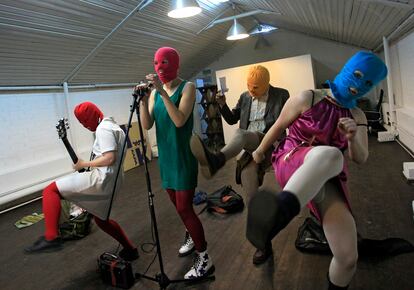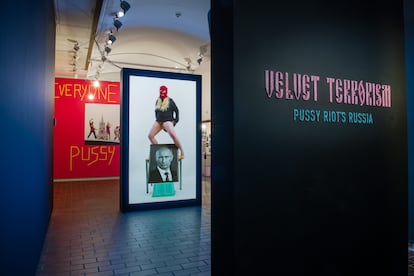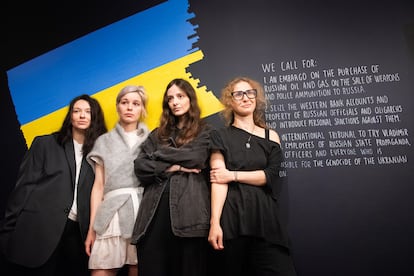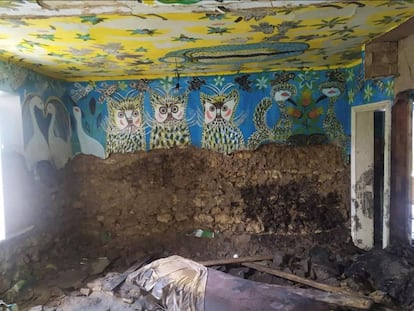Pussy Riot’s 10-year fight against Putin makes it to the museum
An exhibit at the Louisiana Museum of Modern Art in Denmark documents how this women’s collective has made performance the best weapon against the Russian leader


Hundreds of duct-taped photographs, protest videos, songs, court orders, messages written on walls, and even Instagram posts. No poster board is needed, just punk, poetry, humor, and rage. These are framed on colorful walls, which are in the same hues as the group’s balaclavas. The exhibit Velvet Terrorism: Pussy Riot’s Russia, which is open until January 14, 2024, at the Louisiana Museum of Modern Art in Denmark, documents over 10 years of the Russian feminist collective’s protests, spontaneous performances, songs, and activism. Pussy Riot was born in Moscow in 2011 as a protest against Vladimir Putin’s regime. The design of the exhibit suggests a certain urgency and provisional nature, as if stepping into a temporary squatted space from which to flee in case of trouble. But on this late-September Sunday, the public filling the rooms where the exhibit is on display doesn’t seem to be in any hurry.
Fear comes later, when you look at one of the videos: two policemen unceremoniously drag a young woman who is dressed in black and wearing military boots. She screams and struggles to get free, but to no avail. Just before she is put into a van, another woman turns on the camera and records the scene with a cell phone, documenting the arrest of an opponent of the despotic Russian regime. In another recording, people are seen walking, all in the same direction — there are no banners, no shouts or slogans, just people walking. This is how demonstrations are in Putin’s Russia. As if randomly chosen, a person is seized and subdued. Voices are heard, tension is felt. The detainee throws himself to the ground, an officer lifts him up, as if he were a wimp, by the waistband of his pants. The police use that momentum to throw him into a car, but alas, his legs remain outside the vehicle, preventing them from closing the car door. With another knock and push, the door is shut without a problem.
The shocking videos are combined with information about the fate of detainees, prison sentences, electronic anklets used to keep track of political prisoners’ whereabouts at all times, and photos of people with their faces stained with a green liquid used to attack opponents. Usually, the liquid is used as an antiseptic and is difficult to remove, which can cause problems when participating in public activities.
Pussy Riot’s work draws on Dadaism, Fluxus and 20th-century activism, based on bringing performance art to public places. In addition to surprise actions, they write books, tour with their music, participate in debates and give political speeches. A mixture of bravery and humor, Pussy Riot’s performances represent some of the 20th century’s most powerful political actions. Punk Prayer, which ridiculed the union between the Kremlin and the Orthodox Church, occupies a prominent place in the exhibition. That prayer took place in 2012 at Moscow’s Cathedral of Christ the Savior. At the high altar, four girls in miniskirts, colorful stockings and balaclavas shout and chant slogans decrying the political situation. There are just a few seconds of guitar banging and jumping before they are arrested. Three members of the group were arrested and sentenced to two years in jail, charged with religious hate vandalism. Protestors pay a high price in Russia. Bishop Tikhon Shevkunov, the Russian president’s friend, dubbed the spectacle velvet terrorism, which proved to be a good title for an exhibition.

That was not the first time the collective made headlines around the world. Just a year earlier, when the Russian president announced that he was running for re-election, the group launched one of its spontaneous, highly expressive protest actions in Moscow’s Red Square, next to Lenin’s tomb. The pounding rhythm of guitars accompanied the shouts of Pussy Riot, clad in their usual uniforms. Over time, the list of rebellious motifs grew: Putin forever, LGBTIQ+ rights, the release of political prisoners and, more recently, protest against the war in Ukraine are among the collective’s recurring themes.
The Louisiana Museum — located in Humlebaek, by the Baltic Sea, about 25 miles from Copenhagen — has become a leading space for reflecting on modern art. The exhibition is the first of its kind in the world and forms part of the museum’s tradition of engaging with the present, freedom of expression, democracy and human rights. The director, Paul Eric Turner, maintains that “it is an obvious platform for bringing the group’s political art to life.”
‘Humor helps break the terror’
Velvet Terrorism was created over several months in collaboration with Maria Alyokhina, 35, one of Pussy Riot’s leaders. She is known as Masha and Russian authorities consider her to be a “habitual offender,” which, she says, is why she has frequently been arrested on false charges. In an interview with the museum as the exhibit was being mounted, the activist explained that the Russian system aims to generate fear among the population and paralyze it. “We believe that smiles and humor help to break that terror,” she says. Masha describes the current regime as totalitarian and the development from 2012, when she was detained in the Moscow cathedral, until now as “the road to hell,” a journey that reached its lowest point with Russia’s 2022 invasion of Ukraine. Masha, who fled Russia last year — disguised as a food delivery girl — to escape increasing pressure from the Kremlin, says that “the world should unite and protect Ukraine… It’s a constant shame, I don’t want Russia to win.”

Of Putin’s re-election in 2012 and the origins of their struggle, Masha adds that her band already warned about it. “We spoke in different parliaments, I did interviews, talked to politicians, opponents, and people on the street, but it was not only me. [It was not] only Pussy Riot; the opposition warned about the dangers of the regime, but commercial interests became more important than human life.” Pussy Riot’s struggle, she recounts, grew “step by step… When we see something unjust, we react. There was no plan for resistance, although revolution was in our hearts. We used what we had, we were naked before the system, but we did something.”
They did things like attacking a Moscow government building with paper airplanes. Masha was arrested as a result. The image of her holding a blue paper airplane in her hands and being escorted by two policemen is one of the materials on display in the exhibit. The group also filmed videos with a scatological touch. In one of their signature brutal videos, a blonde-haired activist has a picture of Putin between her legs; she lifts up her skirt to her groin and takes a long, loud piss. As she leaves the hall, the Russian anthem plays solemnly. Pussy Riot is already much more than a band. Anyone can be Pussy Riot.
Sign up for our weekly newsletter to get more English-language news coverage from EL PAÍS USA Edition
Tu suscripción se está usando en otro dispositivo
¿Quieres añadir otro usuario a tu suscripción?
Si continúas leyendo en este dispositivo, no se podrá leer en el otro.
FlechaTu suscripción se está usando en otro dispositivo y solo puedes acceder a EL PAÍS desde un dispositivo a la vez.
Si quieres compartir tu cuenta, cambia tu suscripción a la modalidad Premium, así podrás añadir otro usuario. Cada uno accederá con su propia cuenta de email, lo que os permitirá personalizar vuestra experiencia en EL PAÍS.
¿Tienes una suscripción de empresa? Accede aquí para contratar más cuentas.
En el caso de no saber quién está usando tu cuenta, te recomendamos cambiar tu contraseña aquí.
Si decides continuar compartiendo tu cuenta, este mensaje se mostrará en tu dispositivo y en el de la otra persona que está usando tu cuenta de forma indefinida, afectando a tu experiencia de lectura. Puedes consultar aquí los términos y condiciones de la suscripción digital.










































